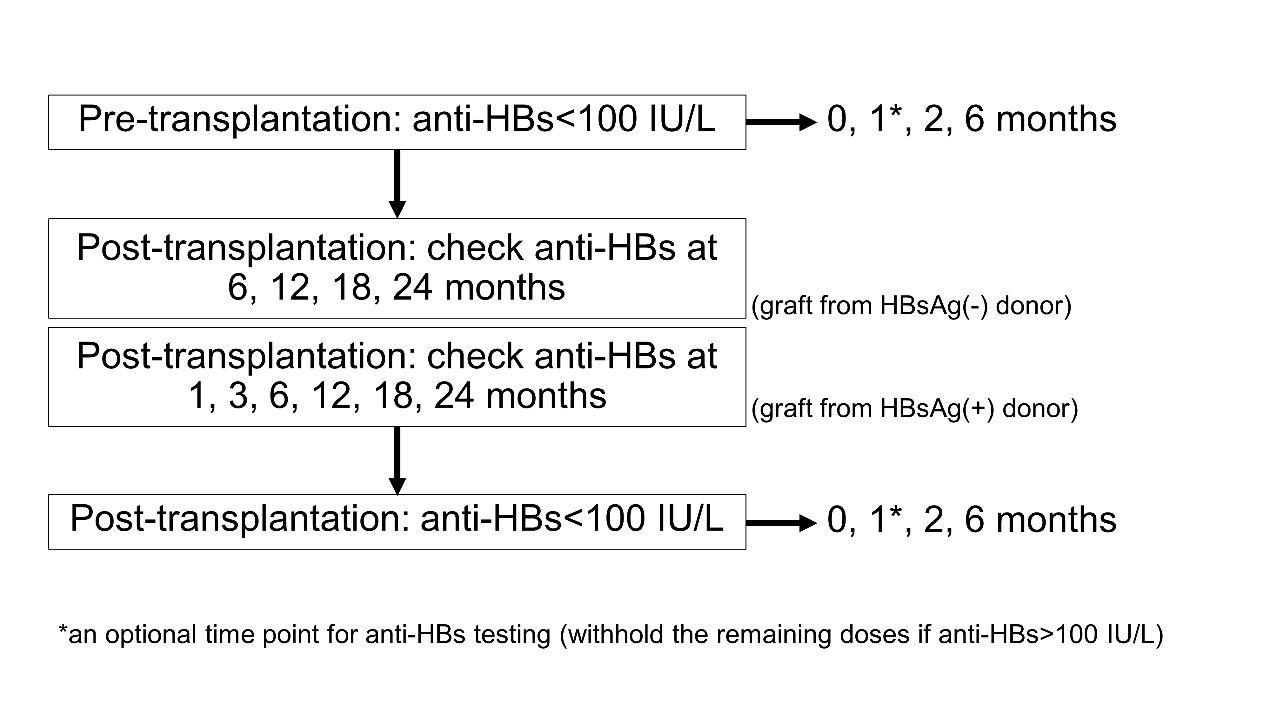The Evolution of Hepatitis B Surface Antibody (Anti-HBs) Titer of the Kidney Transplant Recipients: A 5-Year Experience Guideline for the Optimal Maintaining Immunization.
W. Chancharoenthana, A. Leelahavanichkul, S. Wattanatorn, Y. Avihingsanon, K. Praditpornsilpa, N. Townamchai.
Division of Nephrology, Department of Medicine, Chulalongkorn University, Bangkok, Thailand
Meeting: 2017 American Transplant Congress
Abstract number: A300
Keywords: Hepatitis B, Kidney transplantation
Session Information
Session Name: Poster Session A: Viral Conundrums
Session Type: Poster Session
Date: Saturday, April 29, 2017
Session Time: 5:30pm-7:30pm
 Presentation Time: 5:30pm-7:30pm
Presentation Time: 5:30pm-7:30pm
Location: Hall D1
Background: Immunization against hepatitis B virus (HBV) in kidney transplantation (KT) recipients is recommended as KDIGO guideline. Although hepatitis B surface antibody (anti-HBs) titer of 10 IU/L is admitted to be able to against HBV in general population, anti-HBs titer above 100 IU/L is recommended as the optimal threshold in our center. Therefore, the natural evolution of anti-HBs titer in recipients after KT should be systematically explored for maintaining immunization. We aimed to evaluate the evolution of anti-HBs titers during the following time and propose the optimal timeline including managements of HBV immunization protocol in KT recipients.
Methods: We performed a prospective cohort study with scheduled the anti-HBs titer follow-up timing and immunization as shown.  In brief, all participating patients were KT recipients who had HBsAg(-) and anti-HBs titer above 100 IU/L prior to KT. This immunity level may be natural or passive immunization.
In brief, all participating patients were KT recipients who had HBsAg(-) and anti-HBs titer above 100 IU/L prior to KT. This immunity level may be natural or passive immunization.
Results: All 183 recipients had a reduction of anti-HBs titer after KT. The pattern of reduction rate of anti-HBs titer after transplantation was non-linear. The mean anti-HBs titer half-life (t [frac12]) was 57.8 months. KT recipients with natural immunity had longer natural evolution time of anti-HBs titer compared with who had immunity from passive immunization (23.4 months vs 11.8 months, log rank test p<0.0001). In addition, at 12 months after KT, 6% (11/183) of recipients had lost their protective anti-HBs titer below 100 IU/L. However, these recipients were able to restore their anti-HBs titer with only one double booster dose of HBV vaccine. The cut-off anti-HBs titer that demonstrated all-time effectively maintaining anti-HBs titer above 100 IU/L was 168 IU/L.
Conclusions: The loss of anti-HBs titer levels following year after KT was considerable. For getting the optimal immunity against HBV, KT recipients should be regularly investigated and reimmunized the HBV immunity, particularly when anti-HBs titer was below 200 IU/L.
CITATION INFORMATION: Chancharoenthana W, Leelahavanichkul A, Wattanatorn S, Avihingsanon Y, Praditpornsilpa K, Townamchai N. The Evolution of Hepatitis B Surface Antibody (Anti-HBs) Titer of the Kidney Transplant Recipients: A 5-Year Experience Guideline for the Optimal Maintaining Immunization. Am J Transplant. 2017;17 (suppl 3).
To cite this abstract in AMA style:
Chancharoenthana W, Leelahavanichkul A, Wattanatorn S, Avihingsanon Y, Praditpornsilpa K, Townamchai N. The Evolution of Hepatitis B Surface Antibody (Anti-HBs) Titer of the Kidney Transplant Recipients: A 5-Year Experience Guideline for the Optimal Maintaining Immunization. [abstract]. Am J Transplant. 2017; 17 (suppl 3). https://atcmeetingabstracts.com/abstract/the-evolution-of-hepatitis-b-surface-antibody-anti-hbs-titer-of-the-kidney-transplant-recipients-a-5-year-experience-guideline-for-the-optimal-maintaining-immunization/. Accessed January 6, 2026.« Back to 2017 American Transplant Congress
